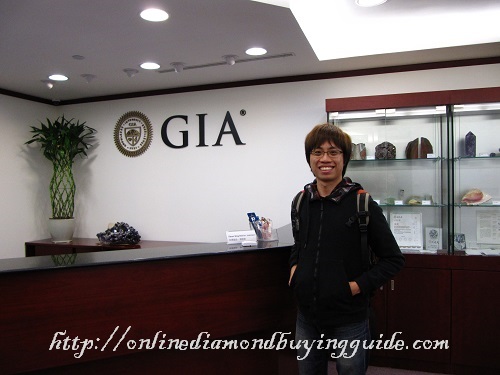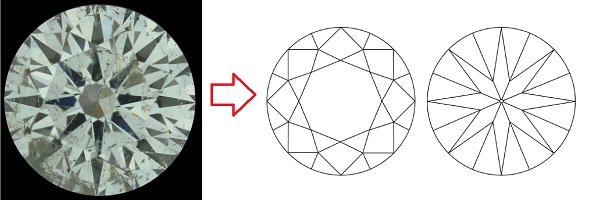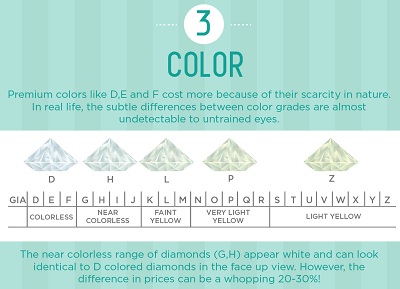My GIA Graduate Diamonds Program Review – My Experience
It’s been a while since the blog was updated. As you can see, much has happened at Beyond4Cs.com since the last post in January. I was kept busy in revamping the website for a new face lift for the earlier part of this year.
And during the month of February, I flew over to Hong Kong to complete a lab grading module for GIA’s diamond graduate program.
While I was in Hong Kong, I took the liberty to explore major retail areas and experience jewelry shopping in this emerging Chinese market. Besides attending the GIA course, my other objective was to pay a visit to my older brother who had been based there for work.
The GIA Hong Kong Course Experience

Let’s kick things off with an overview of the course I’m attending. The entire program constitutes of 3 modules during which, students have the duration of 1 year to complete in their own time. This program is made up of two online self study modules and one practical lab grading class for hands on experience.
For the lab grading module, you are given the choice to attend it any GIA labs around the world. The lab module takes places over 5 full working days and is intensively packed with practical sessions and back to back lectures.
Here’s a Brief Outline of the Lab Program:
Day 1 – Introductory lectures and theoretical lessons.
Day 2 – Theory and practical on grading color, fluorescence and cut.
Day 3 – Hands on session on clarity grading and identification of clarity characteristics.
Day 4 – Full grading practice sessions on 4Cs followed by lecture on fancy shaped diamonds.
Day 5 – 2 stone practical examination followed by lecture on synthetic diamonds and stimulants.
A typical class size consists of 20 people and the majority is made up of professionals from the local jewelry industry. Interestingly, most of these people already have years of experience in the trade. I found out later that they were either looking to enhance their knowledge or were sent by their companies to “upgrade” their skills.

Photography credits: gia.edu
Besides myself, there is only one other person (a local architect) attending this course purely out of interest. The demographics are mainly locals and I see a mix of both ladies and guys ranging from age groups between 25 – 58 years of age.
Due to the strict course rules, no photography was allowed inside the lab during lessons. This was a little disappointing as I wanted to share my experience and offer some sneak peeks into the course.
In essence, the course takes place in a seminar classroom with desks facing a projector screen. On each desk, everyone has an individual table-top microscope and a set of gemological tools like tweezers and pointers.
How I Found the Course’s Pace And Difficulty Level
Overall, the lectures and theory parts of the course are pretty easy to grasp. If you had performed some prior self-study before attending the course, the theoretical lectures are going to be a walk in the park. However, I can’t say the same for the hands on session.
To me, the process of grading clarity is the toughest aspect of the entire program. It was only through the experience of this course that I realized how pampered we all are. For consumers who don’t appreciate how much skill and expertise that goes on inside the GIA lab, it is easy take a grading report for granted.

Don’t believe me? Try drawing all the inclusions onto a blank plot yourself…
The practical exam consists of grading 2 stones in full details (both proportions and finishing) within a timeframe of 2 hours. That equates to an average of an hour for each diamond. Stones were chosen and assigned at random. Amongst everybody in the course, we all had a common consensus – the hope that you won’t be the one receiving severely included diamonds.
Throughout my entire diamond and gemstone buying experiences so far, I had seen thousands of stones with different clarity grades ranging from internally flawless stones to included ones. I can honestly tell you that it isn’t hard to identify inclusions with the corresponding GIA report by your side. All it takes is a little experience and anyone can easily match the stone to the report under a loupe.
However, the opposite holds true when you are given a blank clarity plot with an unknown stone. Having to map out the different inclusion types and their corresponding locations accurately is no easy feat with just a couple of day’s practice. And if you think that an hour’s time to fully grade a diamond might sound long, it isn’t.
Receiving One of the Toughest Pair of I2 Test Diamonds
And as luck would have it. I happened to be the only unlucky person who randomly chose 2 severely included I2 diamonds. Geez… I absolutely hate to map out a diamond with tons of inclusions all over the place. Not only is it easy to miss out on smaller details, it takes way more time to drawing them out.
And I’m not the only one who thinks in this manner. During our practice sessions, the general feedback on I1-I2 diamonds is that they pose a difficult challenge even to my fellow classmates who had years in the trade.
Luckily for me, I was able to draw upon my experiences of inspecting stones critically whenever I go jewelry shopping in Singapore. You see, way before I signed up for GIA’s diploma program, I had already gotten my hands wet in examining diamonds.
Before I started this website, the countless visits I made to the jewelers and the amount of sample stones I bought for self study was way beyond what you would have imagined. Even with limited resources and not having the luxury of working in a store, it didn’t stop me from learning everything I can about diamonds.
You Can Do Anything If You Put Your Mind to It
Here’s the knack I have.
Whenever I inspect a diamond, I would make a note of the type of inclusions found and mentally sketch the locations at the back of my head. The rationale behind this was simple; if I shop for a diamond, I will make sure that the stone I’m looking at matches up to the one stated in the grading report.
Whether it is cut, color, clarity or even physical dimensions, I always make the effort to analyze these details just for fun. To me, it was like a game of challenging myself. Thereafter, I would always ask for the grading report to see and verify it against my assumptions.
Of course, when I first started out, I wasn’t correct most all of the time. Overtime, this trained my eye and built up my expertise. Besides picking up practical experience on the street, I also read widely to build up my knowledge in diamond grading.
These are fantastic books and tools to pick up if you want a headstart to the GIA diamond grading course:
– Diamond Grading ABC – The Manual (My top recommendation)
– MicroWorld of Diamonds: A Visual Reference
– Diamonds in Nature: A Guide to Rough Diamonds
– Diamond Handbook: A Practical Guide to Diamond Evaluation (Newman Gem & Jewelry Series)
– Gemoro GIA Grading Scale 10 Stone Diamond Color Grading Kit (1.00ct)
How Did I Fare In the Test?

I Topped the Class!
Much to the surprise of my course mates, I aced the class despite receiving one of the toughest set of examination diamonds. In a class filled with professionals who had been in the line for years, how could a simple (Gwai Lo) gemstone collector outdo them?
Well, my secret is, there are no secrets. All you need is a keen eye for details, a thirst for knowledge, consistent practice and the passion for finding out why things work the way they are.
Come to think of it, I’m sure I might have made some jewelers upset because I usually spend more time examining diamonds and asking questions without making purchases. This experience that was built up over time did come in handy when test comes to crunch.
All in all, the trip was a very fruitful one. After spending a total of 9 days there, I had gained a better insight into the Asian diamond trade and also made friends with some local jewelers. In fact, the most enjoyable moments were the shared stories and pointers being exchanged with each other.
So, is Hong Kong a great place for diamond shopping for both tourists and locals alike? In my next post, I’m going to share first hand experiences and interesting findings I found out while visiting the local stores.
Related Articles
Leave A Comment












19 Comments
hi, thank you for writing about your gia lab classes experience.
I am taking the same classes this week at gia new york.
I am kind of nervous about the diamonds and diamond grading final exam on friday since i still have some difficulties plotting the inclusions. since i did not have any experience in diamond before. do you have any advice or tricks about plotting and how to pass the final test successfully? please respond to me before friday.
thank you
Unfortunately, there’s really no trick to doing this except with more hands on and experience. Don’t worry too much about the exam. The passing rate is pretty high. Just make sure you get the rest of the diamond grading portions corrects (i.e. cut, color etc…) and you’ll be fine.
All the best!
Hello Paul,
Thank you for this site and sharing your experiences. Can you provide a quick gia distance education review?
In this post you have also said that you worked with sample stones you bought for self study, were they diamond or ordinary ones/simulated stones with inclusion to aid in understanding? Could you please share more details on anything that would help me prepare to take my lab in a couple of months. FYI I have zilch experience with diamonds. Just doing this course out of interest.
Thank you for your help and input,
Su Amar
Enjoy a blessed day, every day!
The gia distance education program is really a self-study course and part of the pre-requisite to get the diploma. In terms of knowledge, you find similar content in the Diamond Grading ABC: The Manual book that I recommended above.
I bought both. On eBay, you can find tons of diamonds with misrepresented quality. Believe it or not, low quality diamonds like these are better for learning than the well cut ones. Go and view more diamonds in stores and try to correlate them with their GIA certificates.
Hi, I’m planning to take GIA graduate diamond at India but my course only requires 3 months and how come your was different than mine? I’d like to know whether the post in the blog was about experience of graduate diamond course at Hong Kong or a different one cos I’m so interested in this industry. and I don’t wanna take wrong class where I can’t use anything with that knowledge.
It should be identical.
Hi paul! Thank you for this site… My girlfriend and I are planning to attend GIÀ diamond course. Of course we have some doubts because the course is very expensive for us. Is this course really renowned as the school says? Do you have find a job easily? Thank you and sorry for some grammatical mistakes.
The GIA course is definitely useful. In terms of job opportunities, you might want to look at the local economy and internship programs.
Hi! I was wondering if you used anything in preparing for the course? I am going to be staring the gemology program so it’s more ententive then just the diamond grading course. Just wondering if u prepared with anything! Thank you!
Start reading the gia.edu blog and education pages. There’s quite a bit of introductory stuff there.
Hi,
Are the GIA programs worth it? I’ve been thinking about enrolling in the Graduate Gemologist (GG) program and/or the Jewelry Design & Technology (JDT) programs for years now. I’m currently an Accountant and want to change careers or at least do something besides Accounting.
Alice, if you are looking for a career in the jewelry industry, the GIA courses are great launch pads to start from.
Hi,friends
Please guide me…
I am a Diamond Grader from india.I have been working in the industry for 10yrs. In the starting of my career i had done a diploma on polished diamond grading.As i am from a middle class family,i hadn’t enough money for the GIA GD course at that time.Then i started working in a retail diamond jewellers as a grader and started
Saving money for the GIA GD course.Now i have already saved the course fees.But the real problem starts now…i told my boss to give me leave for two months,he denied.He told me if i wanted to do the class,i have to leave the job.
I am the only person in my family to earn.
The course duration is two months.I can manage one month more without earning.
The gems &jewellery industry is going very slow now in India.I don’t see any opportunity outside.
Friends,pls advise me…what will be the right decision?
Help!
I’m going to attend gemologist course soon in gia, but i’m new to this industry. Can gia’s course be able to guide a 0% knowledge student to graduate and become an expert inside this industry.
Could you give some insights to the gia exam questions and if you can, the gia diamond essentials test answers for reference.
No. This course is designed to get your feet wet but in no way is it comprehensive. Most of it still relies on hands on knowledge.
Unfortunately, I can’t share the GIA diamond essential test answers as that would be unethical. Also, it may be a futile attempt to get help on the Internet as the questions may change or not be identical to the test I sat for.
Go study up your reference books and notes. It really isn’t that hard.
Hello!
I judged enrolled the GIA essentials for gemstones and diamonds, hoping for the GG completion . I love to buy stone but I didn’t really have many hands on experience in investigating gemstones and diamonds.
I took the courses purely for interest. Do you think the courses are able to give me enough knowledge on the jewellery ?
Also , is it hard for a zero knowledge person to attain the GG level?
I didn’t really hope for a pathway of career into jewels. But I do hope I can have a thing that I can specialise into which I have real interest.
I applied for the distance learning course for both essentials course. Do you think there’s a great difference between on campus and online one since I don’t really have time to go for GG courae for half a year?
Thanks so much!!!
The courses should give you an insight to grading diamond jewelry. From a business perspective (i.e. if you want to run a jewelry business or start one), they aren’t that useful.
To answer your second question, it’s pretty easy for a person with absolutely no knowledge to attain the GG cert. Put in some effort to study and read up. You will do fine.
Unfortunately, I can’t answer the 3rd question here as I personally never been on campus for the course due to work commitment. When I attended the course in Hong Kong, I actually had to take leave from my job to pursue this interest.
Hi there, great post on the topic. I am thinking of taking the GD courses at GIA through Distance Education. Which class should I take next after Diamond Essentials–Diamonds & Diamond Grading class or do you take the Diamond Grading lab first? Thanks for any advice.
Either way is fine. I would say the lab class is easier with the knowledge from the Diamonds Essential course first.